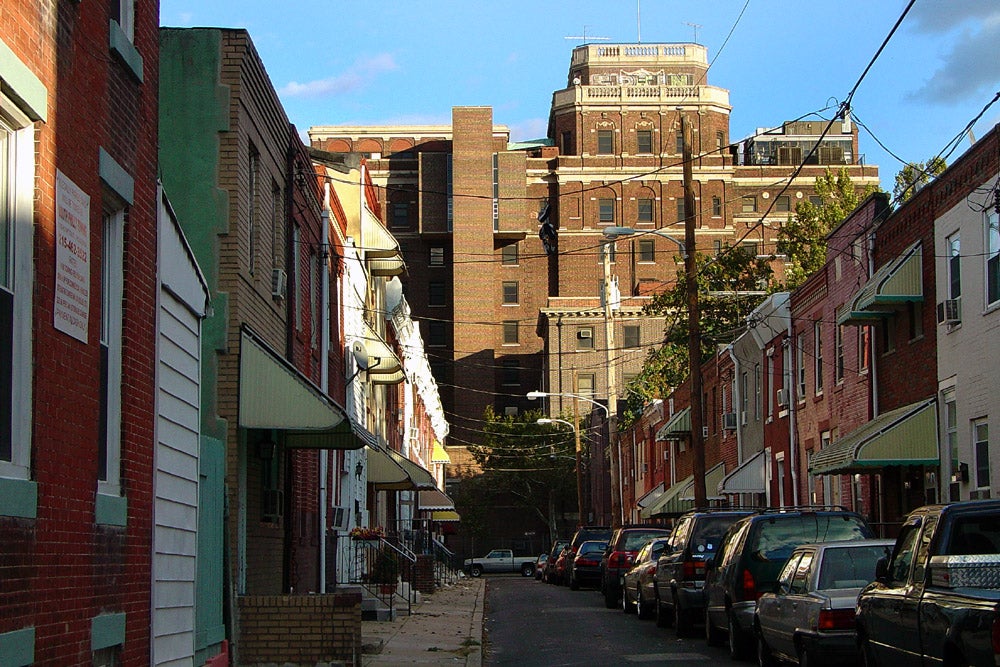Committee asks Mt. Sinai developers to make design changes, return in a month

The developers who are hoping to tear down the vacant Mt. Sinai hospital in Dickinson Square West and replace it with 95 townhomes will have to wait another month before receiving a permit, after the Civic Design Review voted on Tuesday to have them return for a second presentation in September.
Asking developers to re-present is the only legal authority held by the Committee, whose recommendations are advisory only. Ron Patterson, an attorney representing the development group, told the committee that the delay could be “fatal” to the project, after committee member Cecil Baker motioned to have the developers return with updated designs. Nancy Rogo-Trainer, the committee chair, said she didn’t like that suggestion. She didn’t want to set a precedent of letting developers get out of a second presentation by threatening the committee with the failure of a project. The Committee voted to bring them back, with Anne Fadullon, the lone developer on the panel, dissenting.
The committee had a host of concerns about the design of the project, which are discussed below. But there is also a question of process. The developers had the subject property, a whole city block surrounded by 4th, 5th, Reed, and Dickinson, rezoned in City Council. They don’t have to go to the zoning board. But they did have to go through a master-plan review process with the Planning Commission, which already occurred earlier this year. The Commission approved the master plan, but with a proviso stating that the developers would revise the plan if the Civic Design Review Committee had significant comments about its impacts on the public realm.
Community members and members of the committee felt that Civic Design Review should have happened earlier in the process.
The Committee’s comments were significant, and they ranged from general to specific.
Michael Johns, a Committee member, said that the project felt like a gated community even though it doesn’t have gates. Several committee members said the sidewalk leading into the project is too narrow at four feet, and should be widened so as to appear more like a normal public street. Committee member Dan Garofalo pointed out that some of the houses in the internal portion of the property are oddly close together, facing each other. A resident standing in the front room of his house would be closer to the neighbor’s front room than the back wall of his own house, in some of the units.
The Committee said the project should be more welcoming to bikers and pedestrians, even with its 134 parking spaces. Some committee members suggested it was too many houses, with too much square footage, for the property. The development team argue that the density roughly matches that of most other South Philly blocks. They said the rear sides of the houses are unsightly, and will make up most of what the residents and outsiders looking in will see. The two planned rain gardens inside the development are a half-hearted gesture, they suggested. Some stoops on the inside might be nice, said committee member Anita Toby Lager.
“Maybe you have to lose a couple houses in order to make it something special,” she said.
Cecil Baker, an architect who serves on the committee, said the project had virtually nothing to give back to the community. The developers wouldn’t be able to get away with it in his neighborhood, Washington Square West, he said.
“I see this project as supremely ungenerous,” Baker said.
Baker pointed out that one of the partners, Greg Hill of Brown Hill Development, is breaking ground this week on an apartment tower at 205 Race street, which Baker said gives a lot to the surrounding community in terms of design and amenities. The Mt. Sinai project has nothing like that, he said.
“I feel a real poverty of generosity,” Baker said.
Greg Hill said he felt that the Committee’s comments were valid, but the developers are trying to balance the desires of the community (which supports the project overall), the Planning Commission’s comments, and their own economic restraints in order to make the project work.
“Some aspects of this project are not ideal,” Hill said. “But we’re not going to retire early on this.”
“I trust you,” Baker responded. “You represent the classiest of developers, bar none. Sit down with your designers and try to do better.”
After the meeting, Hill said that delays do endanger major development projects, and the idea that waiting another month for the permit could kill the project is not an “idle threat.” He said the group is committed to making the project work, and incorporating as much of the Committee’s comments as they can, but the delay could be harmful.
“Every day we don’t get to closing hurts the chances of success,” Hill said.
If the developers make relatively minor changes to the master plan, like sidewalk widenings, the changes can be approved by the Planning Commission staff without another hearing, according to Commission director Gary Jastrzab.
The group will have to re-present the project to the CDR Committee in early September. It could choose to ignore all the comments and leave the plans untouched.
WHYY is your source for fact-based, in-depth journalism and information. As a nonprofit organization, we rely on financial support from readers like you. Please give today.



